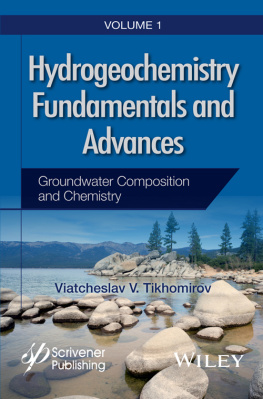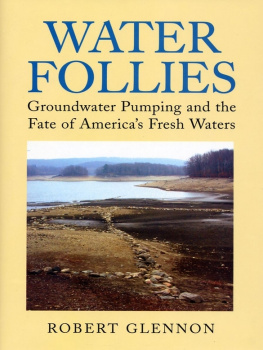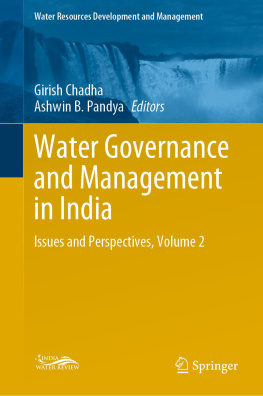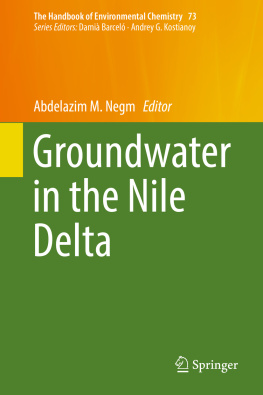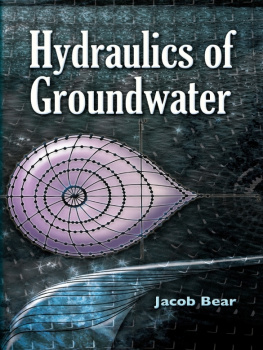Hydrogeochemistry Fundamentals and Advances
Scrivener Publishing
100 Cummings Center, Suite 541J
Beverly, MA 01915-6106
Publishers at Scrivener
Martin Scrivener()
Phillip Carmical ()
Copyright 2016 by Scrivener Publishing LLC. All rights reserved.
Co-published by John Wiley & Sons, Inc. Hoboken, New Jersey, and Scrivener Publishing LLC, Salem, Massachusetts.
Published simultaneously in Canada.
No part of this publication may be reproduced, stored in a retrieval system, or transmitted in any form or by any means, electronic, mechanical, photocopying, recording, scanning, or otherwise, except as permitted under Section 107 or 108 of the 1976 United States Copyright Act, without either the prior written permission of the Publisher, or authorization through payment of the appropriate per-copy fee to the Copyright Clearance Center, Inc., 222 Rosewood Drive, Danvers, MA 01923, (978) 750-8400, fax (978) 750-4470, or on the web at www.copyright.com . Requests to the Publisher for permission should be addressed to the Permissions Department, John Wiley & Sons, Inc., 111 River Street, Hoboken, NJ 07030, (201) 748-6011, fax (201) 748-6008, or online at http://www.wiley.com/go/permission .
Limit of Liability/Disclaimer of Warranty: While the publisher and author have used their best efforts in preparing this book, they make no representations or warranties with respect to the accuracy or completeness of the contents of this book and specifically disclaim any implied warranties of merchantability or fitness for a particular purpose. No warranty may be created or extended by sales representatives or written sales materials. The advice and strategies contained herein may not be suitable for your situation. You should consult with a professional where appropriate. Neither the publisher nor author shall be liable for any loss of profit or any other commercial damages, including but not limited to special, incidental, consequential, or other damages.
For general information on our other products and services or for technical support, please contact our Customer Care Department within the United States at (800) 762-2974, outside the United States at (317) 572-3993 or fax (317) 572-4002.
Wiley also publishes its books in a variety of electronic formats. Some content that appears in print may not be available in electronic formats. For more information about Wiley products, visit our web site at www.wiley.com .
For more information about Scrivener products please visit www.scrivenerpublishing.com .
Library of Congress Cataloging-in-Publication Data:
ISBN 978-1-119-16039-7
My loved women,
to my mother, wife and daughter
dedicated!
Preface
This textbook includes main sections of hydrogeochemistry, methods of its study, terminology and concepts. The textbook is based on the experience and traditions of teaching hydrogeochemistry at the Hydrogeology department of the Sankt-Peterburg State University. These traditions were laid by a brilliant lecturer and scientist Vera Sergeyevna Samarina who taught hydrogeochemistry over a period of almost 40 years and wrote one of the first textbooks in this discipline. These traditions were extended by M.A. Martynova, E.V. Chasovnikova, M.V. Charykova and other lecturers in the department.
The textbook includes three sections. In the first section study methods are reviewed of the geologic mediums hydrogeochemical state. Provided in the section are concepts of analytical ground water composition and properties, and methods of their study. At the conclusion of the section are analysis methods of collected materials, methods of constructing maps, cross-sections and models of ground water geochemical state. The second section introduces spontaneous processes in the water connected with the disruption of thermodynamical equilibrium. The processes are reviewed in consideration of a complex geologic environment, in order to give the idea of methods used for their numerical modeling. The last section reviews external factors of the formation of ground water composition in different climatic and geologic conditions. The spotlight of the section is on the formation of the ground waters composition, their interaction between themselves and with enclosing rocks. Figuratively, if we view the ground water as a living organism, the first section is discussing its anatomy, the second, its psychology and physiology and the third one, its destiny.
As Hilbert Newton Lewis wrote in the foreword to his Chemical thermodynamics, a textbook is sort of a restaurant where one can stay his/her hunger without thinking about complex and meticulous processes forming the raw products This work is exactly such a textbook and does not pretend to argue controversial hydrogeochemical issues. The main objective of the textbook is to serve previously prepared courses in due order, maximum catchy and gustable. For this reason, the main effort was not the search after truth but systematization and presenting already established provisions.
The publication of this textbook was made possible due to the help by all members of the hydrogeology department of the Geologic faculty at the Sankt-Peterburg State University. I am especially indebted to the department head P.K. Konasavsky and to A.A. Potapov who took upon himself the ungrateful labor of reviewing. I would like also to express my sincere gratitude for the advice, help and useful critique to M.A. Martynova and A.A. Schwartz.
Introduction
Hydrogeochemistry is a science of ground water composition and properties. It studies the distribution of ground water of different properties and composition in the conditions of geologic medium, as well as causes and effects of changes in these properties and composition as they affect the economy. Hydrogeochemistry facilitates the understanding of numerous geologic processes and conditions for the formation of economic deposits, and it solves problems of engineering, geology and ecology. Over time, forecasting and controlling ground water properties and composition has grown more significant in the environment of continuously increasing technogenic effect on nature.
Whereas geochemistry deals with chemical elements distribution in the composition of the Earth as a whole and hydrochemistry in the composition of any natural water, hydrogeochemistry concerns the same in the composition only of ground water.
All study methods in hydrogeochemistry lean on the approaches developed in fundamental sciences such as mathematics, chemistry, physics, geology and biology. Thus, to study hydrogeochemistry one needs to have deep knowledge in the basics of these sciences, in particular thermodynamics, chemistry and in recent times also mathematic modeling.
Hydrogeochemistry as an applied science acquired its name relatively late, in the 19201930s. Its emergence was caused by the interest to ground waters and by progress in analytical chemistry, which enabled distinguishing ground waters by the composition. Currently hydrochemistry is a scientific discipline of a great practical value. It provides the knowledge necessary for solving problems in lithology, geochemistry, mineralogy, geophysics, exploration for economic deposits, engineering geology and ecology.
HYDROGEOCHEMISTRY: PREHISTORY AND HISTORY
The emergence of hydrogeochemistry as a science was preceded by a thousand-year long prehistory when the concepts of substance of the water, its properties and composition formed. These concepts, similar in appearance, but different in the taste, color and smell of ground waters had been developing way before the emergence of fundamental sectoral sciences (physics, chemistry, geology, etc.)

